“In Vietnam we were very poor. No money. One year my grandmother buy a popcorn maker. We sell popcorn on the street, make some money. Next year everybody in our town has popcorn maker!” Read More
It goes without saying, but I’ll say it anyway. Eight of us lounging around Chuck Leavell’s grand piano watching him play… Read More
I don’t take this lightly, the struggle to be happy. It seems to be the plague of our time… Read More
This past week Pele died. Edson Arantes de Nascimento was born in Brazil in 1940. He grew up shining shoes to help support his family and buy his meager soccer gear, a game he excelled in… Read More
And New Years Eve, instead of the usual going out in the city, we bought champagne, built a fire, and welcomed the new year sharing… Read More
Some years Santa don’t find us up in the hollow, don’t see the smoke from the stove. The sleigh gets tangled, reindeer lost… Read More
We climb in as the rain begins again. She is spellbound, as I was at her same age forty years ago. Waves rolling in from the Channel, we sit in the raised shelter of the cave. A place of our own, out of the weather, a clear view of the sea. Read More
Were motorcycles somehow less dangerous then? Not inherently. But in general drivers were less distracted, no cell phones. Plus, as a rider, I was learning how to be more aware, to pay attention… Read More
Dr. Phil Stutz is one of the top psychiatrists in the world. Based in Los Angeles, a lot of his clients are movie stars and high achieving creative people. About that, he has this to say… Read More


